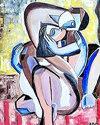交际途径
IF 0.3
4区 社会学
0 HUMANITIES, MULTIDISCIPLINARY
ANGELAKI-JOURNAL OF THE THEORETICAL HUMANITIES
Pub Date : 2023-07-04
DOI:10.1080/0969725X.2023.2233796
引用次数: 0
摘要
摘要见证和见证需要感知,而不是人性。Sentiency在这里被区分为体验元素/实体/存在之间的能量凝聚并从这种遭遇中获得反应的能力。本文以澳大利亚北部卡奔塔利亚湾西南部的Yanyuwa国家的以亲属为中心的生态和生活世界为中心,试图通过“不讨好”的原则来拓展关于见证和见证的讨论的概念根源,在这种情况下,人类往往无法超越当前思维框架的界限、我们存在的极限、我们的本体论、认识论和道德习惯(Sousanis,Unflatting(Harvard UP,2015))。在澳大利亚这样的定居者殖民背景下,这些条件反映了西方占主导地位的认识传统,这种传统依赖于某些本体论习惯,反映了资本主义、现代、新自由主义和个人主义倾向。但这并不是澳大利亚大片土地上存在的唯一法律和认识方式,正如不同土著语言群体的语言和法律所描绘的那样。在烟雨洼国,各种主体之间的交流是常见的,从人与人之间的交流,到作为“老人”居住在该国的已故亲属,到成为国家化身的祖先,再到非人的动物、元素、物体和场所。每个人都有沟通的能力;无论是对彼此认可的表达,情感状态的揭示,健康或混乱,对他人存在的反应,法律和地方经验主义。根据我与延玉洼家族的人种学遭遇,在本文中,我的目标是在三个方面保持冷静:第一,扩大潜在沟通途径的关系范围,将感知存在作为关系的催化剂(通过对存在的反应和存在之间的反应来实现),第二,研究证词的多维性质,扩大我们对见证制定的愿景&考虑谁、什么以及什么时候。我认为土著人,特别是Yanyuwa,是关系本体论,因为它们在感知和交流意图的领域将人类和非人类联系在一起,将焦点或原始取向转移到人类的任何一边和周围。本文章由计算机程序翻译,如有差异,请以英文原文为准。
Communicative Pathways
Abstract Testimony and witnessing require sentiency, not humanity. Sentiency is distinguished here as the capacity to experience energetic coalescing between elements/entities/presences and to derive a response from such encounters. Taking as its focal point the kincentric ecology and lifeworld of Yanyuwa Country in the south-west Gulf of Carpentaria, northern Australia, this paper strives to expand the conceptual roots for a discussion of testimony and witnessing through the principle of “unflattening.” Unflattening is a commitment of orientation, one that counteracts the type of narrow, rigid thinking that is flatness, a condition in which humans are often unable to see past the boundaries of current frames of mind, the limits of our existence, our ontology, epistemic and moral habit (Sousanis, Unflattening (Harvard UP, 2015)). In a settler colonial context such as Australia, these are conditions which reflect a dominant epistemic tradition of the West, which relies upon certain ontological habits, reflective of a capitalist, modern, neo-liberal and individualistic tendency. But this is not the only Law and way of knowing that exists across the great landmass of Australia, mapped as it is by the languages and Laws of diverse Indigenous language groups. In Yanyuwa Country, communication between multifarious agents is common, ranging from those between humans, deceased kin who reside as “old people” in Country, Ancestral Beings which have become the embodiment of Country, non-human animals, elements, objects and places. Each and all are capable of communicating; be it as expressions of recognition of one another, revelation of emotional states, health or disorder, responsivity to the presence of others, Law and local empiricism. Drawing on my ethnographic encounters with Yanyuwa families, I aim, throughout this paper, to unflatten on three fronts: first, expand the relational scope of potential communicative pathways to take in sentient presence as a catalyst for relationality (carried forth by responsiveness to and between presences), second, examine the multidimensional nature of testimony and third, expand our vision of the enactment of witnessing – to consider who, what and when. I consider Indigenous, specifically Yanyuwa, relational ontologies as they bond and unify the human and non-human across a field of sentiency and communicative intention, shifting the focus or primal orientation to either side of and all around the human.
求助全文
通过发布文献求助,成功后即可免费获取论文全文。
去求助
来源期刊

ANGELAKI-JOURNAL OF THE THEORETICAL HUMANITIES
HUMANITIES, MULTIDISCIPLINARY-
CiteScore
0.60
自引率
33.30%
发文量
57
期刊介绍:
Angelaki: journal of the theoretical humanities was established in September 1993 to provide an international forum for vanguard work in the theoretical humanities. In itself a contentious category, "theoretical humanities" represents the productive nexus of work in the disciplinary fields of literary criticism and theory, philosophy, and cultural studies. The journal is dedicated to the refreshing of intellectual coordinates, and to the challenging and vivifying process of re-thinking. Angelaki: journal of the theoretical humanities encourages a critical engagement with theory in terms of disciplinary development and intellectual and political usefulness, the inquiry into and articulation of culture.
 求助内容:
求助内容: 应助结果提醒方式:
应助结果提醒方式:


